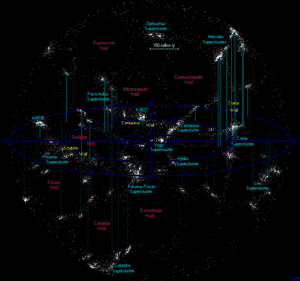Void (astronomy)
In astronomy, voids are the empty spaces between filaments. Filaments and voids are the largest-scale structures in the Universe. There are no or few galaxies in voids. Most voids have a diameter of 11 to 150 Mpc. Especially large voids are the empty spaces without many superclusters. These voids are sometimes called supervoids.

Nearby superclusters and voids
A 1994 official counting lists a total of 27 supervoids with a distance of up to 740 Mpc.[1]
| # | Name | Distance (Mpc) | Diameter (Mpc) |
|---|---|---|---|
| 1 | 188 | 124 | |
| 5 | 182 | 130 | |
| 9 | Southern Local Supervoid | 135 | 158 |
| 18 | 168 | 144 | |
| 19 | 168 | 152 | |
| 20 | Bootes Void | 304 | 110 |
| 21 | 201 | 163 | |
| 24 | Northern Local Supervoid | 86 | 146 |
References
- Lindner U, J. Einasto, M. Einasto, W. Freudling, K. Fricke, E. Tago. 1995. The structure of supervoids. I. Void hierarchy in the Northern Local Supervoid., Astron. Astrophys., v.301, p.329
This article is issued from Wikipedia. The text is licensed under Creative Commons - Attribution - Sharealike. Additional terms may apply for the media files.